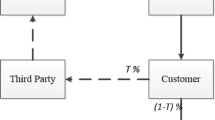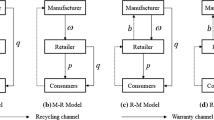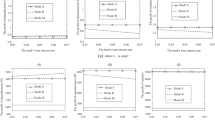Abstract
Remanufacturing is an advanced form of recycling in circular economy. In order to promote the development of remanufacturing, the government gradually uses subsidy policies to regulate and intervene related enterprises. In this paper, we assume that a closed-loop supply chain consists of an original equipment manufacturer (OEM) producing new products from raw materials, a remanufacturer producing re-manufactured products from used items directly collected from customers, and a logistics provider which sells and distributes two products as a monopolist in the given market. By constructing game model in which logistics provider is a leader and OEM and remanufacturer are the equal status followers, we solve chain members’ optimal services decision-making under government subsidy. Finally, considering the government subsidy, we analyze the impact of remanufacturer service level and the logistics provider service scope on members’ equilibrium decision-making. Analysis shows that government subsidy policies are always profitable for enterprises. The OEM and the logistics provider have the same choice. They would choose the subsidy policy for the service scope of the logistics supplier in order to improve the service level of new products and the service scope of the logistics supplier. The remanufacturer would believe that subsidizing the service level of remanufactured products is more effective in improving his own profits.





Similar content being viewed by others
Data availability
This manuscript only includes numerical simulation. Hence, it does not involve data and materials.
References
Atasu A, Sarvary M, Van Wassenhove LN (2008) Remanufacturing as a marketing strategy. Manage Sci 54(10):1731–1746
Cattani KD, Gilland WG, Heese HS, Swaminathan JM (2006) Boiling frogs: pricing strategies for a manufacturer adding a direct channel that competes with the traditional channel. Prod Oper Manag 15(1):40–56
Chiang WK, Chhajed D, Hess JD (2003) Direct marketing, indirect profits: a strategic analysis of dual-channel supply-chain design. Manage Sci 49(1):1–20
Chiang WK, Monahan GE (2005) Managing inventories in a two-echelon dual channel supply chain. Eur J Oper Res 162(2):325–341
Cohen MA, Whang S (1997) Competing in product and service: a product life-cycle model. Manage Sci 43(4):535–545
Dan B, Xu G, Liu C (2012) Pricing policies in a dual-channel supply chain with retail service. Int J Prod Econ 139(1):312–320
Geyskens I, Gielens K, Dekimpe MG (2002) The market valuation of internet channel additions. J Marketing 66(2):102–119
Govindan K, Palaniappan M, Zhu Q, Kannan D (2012) Analysis of third party reverse logistics provider using interpretive structural modeling. Int J Prod Econ 140(1):204–211
Guide VDR, Van Wassenhove LN (2009) The evolution of closed-loop supply chain research. Oper Res 57(1):10–18
He Q, Wang N, Yang Z, He Z, Jiang B (2019) Competitive collection under channel inconvenience in closed-loop supply chain. Eur J Oper Res 275(1):155–166
Jena SK, Ghadge A, Sarmah SP (2018) Managing channel profit and total surplus in a closed-loop supply chain network. J Oper Res Soc 69(9):1345–1356
Jiang C, Xu F, Sheng Z (2010) Pricing strategy in a dual-channel and remanufacturing supply chain system. Int J Syst Sci 41(7):909–921
Khorshidvand B, Soleimani H, Sibdari S, Mehdi SEM (2021) A hybrid modeling approach for green and sustainable closed-loop supply chain considering price, advertisement and uncertain demands. Comput Ind Eng 157
Kovach JJ, Atasu A, Banerjee S (2018) Salesforce incentives and remanufacturing. Prod Oper Manag 27(3):516–530
Li W, Wu H, Jin M (2017) Two-stage remanufacturing decision makings considering product life cycle and consumer perception. J Clean Prod 161:581–590
Ma WM, Zhao Z, Ke H (2013) Dual-channel closed-loop supply chain with government consumption-subsidy. Eur J Oper Res 226:221–227
Maryam J, Seyyed-M H-M (2019) Coordination of social welfare, collecting, recycling and pricing decisions in a competitive sustainable closed-loop supply chain: a case for lead-acid battery. Ann Oper Res 1–36
Mehmet A, Onur KZ, Pelin B (2020) Closing the loop in supply chains: economic and environmental effects. Comput Ind Eng 142:106366
Mitra S, Webster S (2008) Competition in remanufacturing and the effects of government subsidies. Int J Prod Econ 111(2):287–298
Nikunja MM, Nima K, Leopoldo EC-B (2019) Investigating structure of a two-echelon closed-loop supply chain using social work donation as a Corporate Social Responsibility practice. Int J Prod Econ 207:19–33
Panda S, Modak NM, Eduardo Cardenas-Barron L (2017) Coordinating a socially responsible closed-loop supply chain with product recycling. Int J Prod Econ 188:11–21
Savaskan RC, Bhattacharya S, Van WLN (2004) Closed-loop supply chain models with product remanufacturing. Manage Sci 50(2):239–252
Thierry M, Salomon M, Van NJ, Van WLN (1995) Strategic issues in product recovery management. Calif Manage Rev 37(2):114–135
Tsay AA, Agrawal N (2000) Channel dynamics under price and service competition. Manuf Serv Op 2(4):372–391
Wu CH (2012) Price and service competition between new and remanufactured products in a two-echelon supply chain. Int J Prod Econ 140(1):496–507
Wu X, Zhou Y (2019) Buyer-specific versus uniform pricing in a closed-loop supply chain with third-party remanufacturing. Eur J Oper Res 273(2):548–560
Xia Y, Gilbert SM (2007) Strategic interactions between channel structure and demand enhancing services. Eur J Oper Res 181(1):252–265
Zou ZB, Wang JJ, Deng GS (2012) Third-party remanufacturing mode selection: Outsourcing or authorization? Transport Res E-Log 87:1–19
Acknowledgements
The author thanks the editor and two anonymous reviewers for their constructive comments. This study was partially supported by National Natural Science Foundation of China (71971078; 71601074), National Social Science Fund of China (No. 19BGL002).
Funding
This study was partially supported by National Natural Science Foundation of China (71971078; 71601074), National Social Science Fund of China (No. 19BGL002).
Author information
Authors and Affiliations
Contributions
Conceptualization: W. Li and L. Deng. Methodology: L. Deng. Software: F. Chen. Validation: L. Deng, W. Li, and F. Chen. Formal analysis: F. Chen and Y. Zhao. Investigation: W. Li. Resources: L. Deng. Data curation: F. Chen. Writing—original draft preparation: W. Li and L. Deng. Writing—review and editing: Y. Zhao. Visualization: W. Li. Supervision: W. Li. Project administration: L. Deng. Funding acquisition: L. Deng. All authors have read and agreed to the published version of the manuscript.
Corresponding author
Ethics declarations
Ethics approval
The manuscript discusses supply chain issues and includes only theoretical analysis and numerical simulation of supply chains. Therefore, it does not address any ethical issues.
Consent to participate
The manuscript only includes numerical simulation, so it does not involve participants and consent to participate.
Consent to publish
All authors have agreed to publish.
Competing interests
The authors declare no competing interests.
Additional information
Communicated by Philippe Garrigues.
Publisher's Note
Springer Nature remains neutral with regard to jurisdictional claims in published maps and institutional affiliations.
Appendix
Appendix
-
1.
Symbols and Their Meaning
Symbol
Meaning
Symbol
\(j\)
\(j\in \{r,n\}\), \(r\), and \(n\) represent remanufactured products and new products, respectively
\(b\)
Remanufacturer’s recovery cost
\(c\)
Each manufacturer’s product cost
\(d_{j}\)
Market demand for product \(j\), \(j \in \{ r,n\}\)
\(m\)
Manufacturer’s service investment cost
\(m_{l}\)
Logistics costs of logistics providers
\(s_{j}\)
The service level of product \(j\)
\(p\)
For the selling price of the product, it is assumed that the new product will sell for the same price as the remanufactured product
\(l\)
The service scope of logistic providers
\(\delta\)
Cost savings in remanufacturing
\(\tau\)
Degree of remanufacturing
\(\pi\)
Profit function
\(\alpha_{j}\)
The market basis of product j refers to the market size when the product price is fixed and there is no service
\(\beta_{s}\)
Represents the service flexibility of market demand
\(\gamma_{s}\)
The degree of competition for services
Subscript
\(r,n\)
\(r\) and \(n\) represent remanufactured products and new products, respectively
\(s\)
Service
\(l\)
Logistic providers
Superscript
\(M\)
Manufactures
\(^{b}\)
The optimal reaction function
*
Nash Equilibrium
-
2.
Proof of Corollary 1
$$\frac{\partial {l}^{*}}{\partial {m}_{l}}=\frac{(-{\alpha }_{n}-{\alpha }_{r}+2{\beta }_{p}p)h{m}^{2}}{{[2{\beta }_{s}h({\beta }_{s}-{\gamma }_{s})(2p-2c-2h+\delta \tau )-{m}_{l}m]}^{2}}<0,$$$$\frac{{\partial {s_n}^*}}{{\partial {m_l}}} = \frac{{( - p + c + h){\beta _s}({\alpha _n} + {\alpha _r} - 2{\beta _p}p)h{m^{}}}}{{{{[2{\beta _s}h({\beta _s} - {\gamma _s})(2p - 2c - 2h + \delta \tau ) - {m_l}m]}^2}}} < 0$$$$\frac{{\partial {s_r}^*}}{{\partial {m_l}}} = \frac{{( - p + c + h - \delta \tau ){\beta _s}({\alpha _n} + {\alpha _r} - 2{\beta _p}p)h{m^{}}}}{{{{[2{\beta _s}h({\beta _s} - {\gamma _s})(2p - 2c - 2h + \delta \tau ) - {m_l}m]}^2}}} < 0$$Due to \(\frac{\partial {l}^{*}}{\partial {m}_{l}}<0,\frac{\partial {s}_{n}^{*}}{\partial {m}_{l}}<0,\frac{\partial {s}_{r}^{*}}{\partial {m}_{l}}<0,\) \({l}^{*},{s}_{n}^{*},{s}_{r}^{*}\) decreases with the increase of \(m_{l}\).
-
3.
Proof of Corollary 2
$$\frac{\partial {l}^{*}}{\partial m}=\frac{-2({\alpha }_{n}+{\alpha }_{r}-2{\beta }_{p}p){h}^{2}{\beta }_{s}({\beta }_{s}-{\gamma }_{s})(2p-2c-2h+\delta \tau )}{{[2{\beta }_{s}h({\beta }_{s}-{\gamma }_{s})(2p-2c-2h+\delta \tau )-{m}_{l}m]}^{2}},$$$$\frac{\partial {s}_{n}{}^{*}}{\partial m}=\frac{(-p+c+h){\beta }_{s}({\alpha }_{n}+{\alpha }_{r}-2{\beta }_{p}p)h{m}_{l}}{{[2{\beta }_{s}h({\beta }_{s}-{\gamma }_{s})(2p-2c-2h+\delta \tau )-{m}_{l}m]}^{2}}<0$$$$\frac{\partial {s}_{r}{}^{*}}{\partial m}=\frac{(-p+c+h-\delta \tau ){\beta }_{s}({\alpha }_{n}+{\alpha }_{r}-2{\beta }_{p}p)h{m}_{l}}{{[2{\beta }_{s}h({\beta }_{s}-{\gamma }_{s})(2p-2c-2h+\delta \tau )-{m}_{l}m]}^{2}}<0,\left(p+\delta \tau >c+h\right)$$Because \(\frac{\partial {s}_{n}^{*}}{\partial m}<0,\frac{\partial {s}_{r}^{*}}{\partial m}<0\), \({s}_{n}^{*},{s}_{r}^{*}\) decrease with the increase of \(m\). When \({\beta }_{s}>{\gamma }_{s},\frac{\partial {l}^{*}}{\partial m}<0;{\beta }_{s}<{\gamma }_{s},\frac{\partial {l}^{*}}{\partial m}>0\), that is, when \({\beta }_{s}>{\gamma }_{s}\), \(l^{*}\) decrease with the increase of \(m\); When \(\beta_{s} < \gamma_{s}\), \(l^{*}\) increases as \(m\) increases; When \(\beta_{s} = \gamma_{s}\), \(l^{*} = \frac{{(\alpha_{n} + \alpha_{r} - 2\beta_{p} p)h}}{{m_{l} }}\) is not affected by the change of \(m\).
-
4.
Proof of Corollary 3
$$\frac{\partial {l}^{*}}{\partial \tau }=\frac{2({\alpha }_{n}+{\alpha }_{r}-2{\beta }_{p}p){h}^{2}m{\beta }_{s}({\beta }_{s}-{\gamma }_{s})\delta }{{[2{\beta }_{s}h({\beta }_{s}-{\gamma }_{s})(2p-2c-2h+\delta \tau )-{m}_{l}m]}^{2}}, \frac{\partial {s}_{n}{}^{*}}{\partial \tau }=\frac{2(p-c-h){\beta }_{s}{}^{2}({\alpha }_{n}+{\alpha }_{r}-2{\beta }_{p}p){h}^{2}({\beta }_{s}-{\gamma }_{s})\delta }{{[2{\beta }_{s}h({\beta }_{s}-{\gamma }_{s})(2p-2c-2h+\delta \tau )-{m}_{l}m]}^{2}},$$$$\frac{\partial {s}_{r}{}^{*}}{\partial \tau }=\frac{-{\beta }_{s}({\alpha }_{n}+{\alpha }_{r}-2{\beta }_{p}p)h[2{\beta }_{s}h({\beta }_{s}-{\gamma }_{s})(2p-2c-2h)-{m}_{l}m]}{{[2{\beta }_{s}h({\beta }_{s}-{\gamma }_{s})(2p-2c-2h+\delta \tau )-{m}_{l}m]}^{2}}>0,$$When \({\beta }_{s}>{\gamma }_{s}\), \(\frac{\partial {l}^{*}}{\partial \tau }>0,\frac{\partial {s}_{n}^{*}}{\partial \tau }>0,\) \({l}^{*}\) increases as \(\tau\) increases, and \(s_{n}^{*}\) increases with the increase of \(\tau\); when \(\beta_{s} < \gamma_{s}\), \(\frac{{\partial l^{*} }}{\partial \tau } < 0,\frac{{\partial s_{n}^{*} }}{\partial \tau } < 0,\) \(l^{*}\) decreases with the increase of \(\tau\), and \(s_{n}^{*}\) decreases with the increase of \(\tau\); When \(\beta_{s} = \gamma_{s}\), \(l^{*} = {\raise0.7ex\hbox{${(\alpha_{n} + \alpha_{r} - 2\beta_{p} p)h}$} \!\mathord{\left/ {\vphantom {{(\alpha_{n} + \alpha_{r} - 2\beta_{p} p)h} {m_{l} }}}\right.\kern-\nulldelimiterspace} \!\lower0.7ex\hbox{${m_{l} }$}}\), \(s_n^* = (p-c-h)\beta_s(\alpha_n+\alpha_r - 2\beta_p p)h/-m_l m\), \(l^{*} ,s_{n}^{*}\), and \(\tau\) are not related. Since \(\frac{{\partial s_{r}^{*} }}{\partial \tau } > 0,\) \(s_{r}^{*}\) increases with the increase of \(\tau\). The effect of \(\delta\) on \(l^{*} ,s_{n}^{*} ,s_{r}^{*}\) is the same as that of \(\tau\).
-
5.
Proof of corollary 4
$$\frac{\partial {l}^{*}}{\partial c}=\frac{4(-{\alpha }_{n}-{\alpha }_{r}+2{\beta }_{p}p){h}^{2}m{\beta }_{s}({\beta }_{s}-{\gamma }_{s})}{{[2{\beta }_{s}h({\beta }_{s}-{\gamma }_{s})(2p-2c-2h+\delta \tau )-{m}_{l}m]}^{2}},\frac{\partial {s}_{n}{}^{*}}{\partial c}=\frac{{\beta }_{s}({\alpha }_{n}+{\alpha }_{r}-2{\beta }_{p}p)h[2{\beta }_{s}h\delta \tau ({\beta }_{s}-{\gamma }_{s})-{m}_{l}m]}{{[2{\beta }_{s}h({\beta }_{s}-{\gamma }_{s})(2p-2c-2h+\delta \tau )-{m}_{l}m]}^{2}}<0.$$$$\frac{\partial {s}_{r}{}^{*}}{\partial c}=\frac{-{\beta }_{s}({\alpha }_{n}+{\alpha }_{r}-2{\beta }_{p}p)h[2{\beta }_{s}h\delta \tau ({\beta }_{s}-{\gamma }_{s})+{m}_{l}m]}{{[2{\beta }_{s}h({\beta }_{s}-{\gamma }_{s})(2p-2c-2h+\delta \tau )-{m}_{l}m]}^{2}},$$When \({\beta }_{s}>{\gamma }_{s}\),\(\frac{\partial {l}^{*}}{\partial c}<0,\frac{\partial {s}_{r}^{*}}{\partial c}<0,\) \({l}^{*}\) decreases with the increase of \(c\), and \(s_{r}^{*}\) decreases with the increase of \(c\); When \(\beta_{s} < \gamma_{s}\), \(\frac{{\partial l^{*} }}{\partial c} > 0,\) \(l^{*}\) expands with the increase of \(c\), and \(\frac{{\partial s_{r}^{*} }}{\partial c}\) depends on the size of \([2\beta_{s} h\delta \tau (\beta_{s} - \gamma_{s} ) + m_{l} m]\). Since \(\frac{{\partial s_{n}^{*} }}{\partial c} < 0,\) \(s_{n}^{*}\) decreases with the increase of \(c\). When \(\beta_{s} = \gamma_{s}\), \(l^{*}\) and \(c\) are not related, \(\frac{{\partial s_{r}^{*} }}{\partial c} = \frac{{\partial s_{n}^{*} }}{\partial c} < 0,\) \(s_{n}^{*} ,s_{r}^{*}\) decreases with the increase of \(c\), and the decreasing trend is the same.
Rights and permissions
About this article
Cite this article
Li, W., Chen, F., Deng, L. et al. Research on services decision-making in closed-loop supply chain dominated by a logistics provider. Environ Sci Pollut Res 29, 55945–55956 (2022). https://doi.org/10.1007/s11356-022-19361-1
Received:
Accepted:
Published:
Issue Date:
DOI: https://doi.org/10.1007/s11356-022-19361-1




